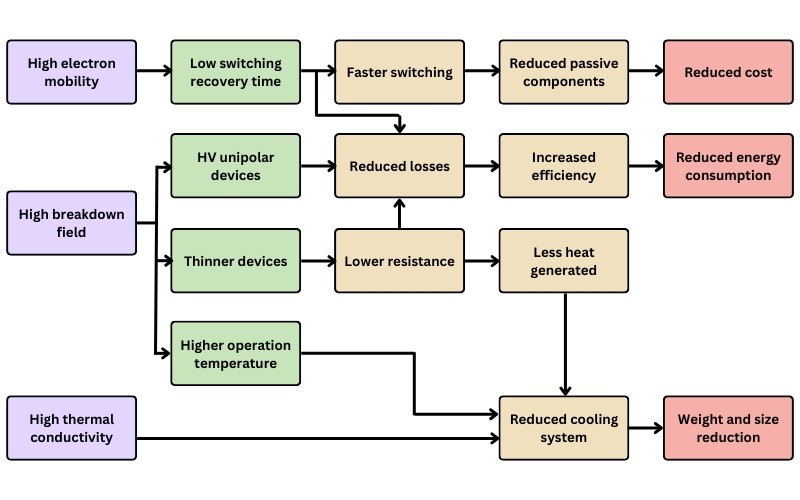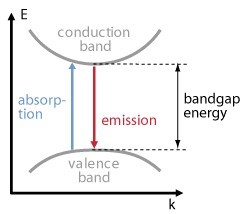

【Knowledge Discover】How semiconductor materials affect EV power electronics?
日期:2025-05-13阅读:845
Different semiconductor materials have different properties that affect their thermal performance and power efficiency for electric vehicle (EV) applications. Notable material properties include bandgap energy, critical electric field, electron mobility, electron saturation velocity, and thermal conductivity.
This article explains how each material property affects power electronics and discusses six semiconductor materials to determine how each suits EV power electronics applications.
Figure 1 shows a flowchart with electron mobility, breakdown field, and thermal conductivity as the semiconductor material properties to understand their effect on power electronics design. The flowchart clearly shows that the material properties are not independent and share a relationship.

Figure 1. A flowchart showing how properties of a semiconductor material affect thermal management and efficiency in the power electronics design.
Effect of bandgap energy (EG) and critical electric field (Ecrit)
For a semiconductor material to act as a conductor, the electron should move from the valence band to the conduction band. The amount of energy required to do so is called bandgap energy, as shown in Figure 2.
When a semiconductor material has wider bandgap energy, a higher voltage can be applied across the semiconductor without the effect of electric breakdown. It also leads to thinner drive regions and reduced on-state resistance.
When on-state resistance reduces, it leads to lower conduction losses. This, in turn, leads to lower heat generated, and cooling becomes easier. Lower conduction losses also enhance the efficiency of the semiconductor device.

Figure 2. An illustration of the bandgap energy between the valence band and the conduction band of a semiconductor.
Effect of electron mobility (μe)
Electron mobility of a semiconductor material measures how quickly an electron can move when an electric field is applied. Therefore, for higher electron mobility, the electron moves more freely, which results in improved conductivity.
The switching speed also increases when electrons are more mobile, and a higher switching speed in power electronics translates into a need for smaller passive components. Therefore, the size of the overall product, along with the heat sink size for thermal management, is reduced.
Effect of electron saturation velocity (vs)
Electron saturation velocity is the maximum velocity an electron can reach under the influence of an electric field. The higher the value of vs, the more the device can handle higher current density without excessive voltage drops. So, the form factor of the product decreases when power density increases.
Effect of thermal conductivity (kth)
Thermal conductivity directly represents how well a semiconductor device can handle operating temperature. A semiconductor with a higher thermal conductivity can dissipate more heat without increasing cooling system requirements.
Exploring the material properties of commercially available and promising semiconductors
The most commonly used and commercially available semiconductor materials for power electronics applications in EVs are silicon (Si), silicon carbide (SiC), and gallium nitride (GaN).
However, three more semiconductor materials have promising properties, but they are still under research and development. They’re gallium oxide (β-Ga2O3), diamond, and aluminum nitride (AlN). The material properties of all six semiconductors are compiled in Figure 3.

Figure 3. A comparison of Si, SiC, GaN, gallium oxide, diamond, and aluminum nitride material properties.
Based on Figure 3, we will analyze all six semiconductors and see how each one fares against their respective material properties.
Silicon (Si): Due to its mature technology, Si is the most commonly available and commercially used on a large scale for different power electronics applications. However, its lower bandgap energy and critical electric field mean it has a lower voltage-blocking capacity, which is unsuitable for EV applications. The thermal conductivity is unimpressive, resulting in poor thermal dissipation and an inability to handle higher temperatures, as with EVs.
Silicon Carbide (SiC): SiC has a favorable balance of material properties for EV power electronics. It offers higher bandgap energy and a critical electric field, leading to a higher operating voltage. SiC also has significantly higher thermal conductivity than Si. This enables higher efficiency, higher operating temperatures, and reduced cooling requirements.
Gallium Nitride (GaN): GaN’s specialty is its high electron mobility, which results in a higher switching speed for high-frequency applications in EVs. The higher critical electric field also means lower on-state resistance, leading to lower conduction loss. But the thermal conductivity is only two-thirds of SiC, raising concerns from power electronics engineers about thermal management.
Gallium Oxide (β-Ga2O3): Gallium oxide’s higher bandgap energy and critical electric field help achieve a higher device operating voltage. However, the low electron mobility and poor thermal conductivity means it’s not a semiconductor material option for EV power electronics applications.
Diamond: Diamond has the highest thermal conductivity, nearly 10 times GaN’s, and the electron mobility is very high at 4500 cm2/Vs. The other properties are also on par with GaN’s properties, but there are challenges in doping and fabrication. Diamonds are also far more costly, which adds to the limitation for commercial purposes.
Aluminum Nitride (AlN): Aluminum nitride has the highest bandgap energy and critical electric field of all six materials. Further research is needed to overcome its lower electron mobility and immature fabrication technology.
Summary
The most suitable semiconductor materials for EV power electronics applications are SiC and GaN due to their wide bandgap energy and higher thermal conductivity compared to Si. The promising semiconductor materials, i.e., gallium oxide, diamond, and aluminum nitride, need better fabrication processes, reduced cost, and further research to make them suitable for EV applications.


